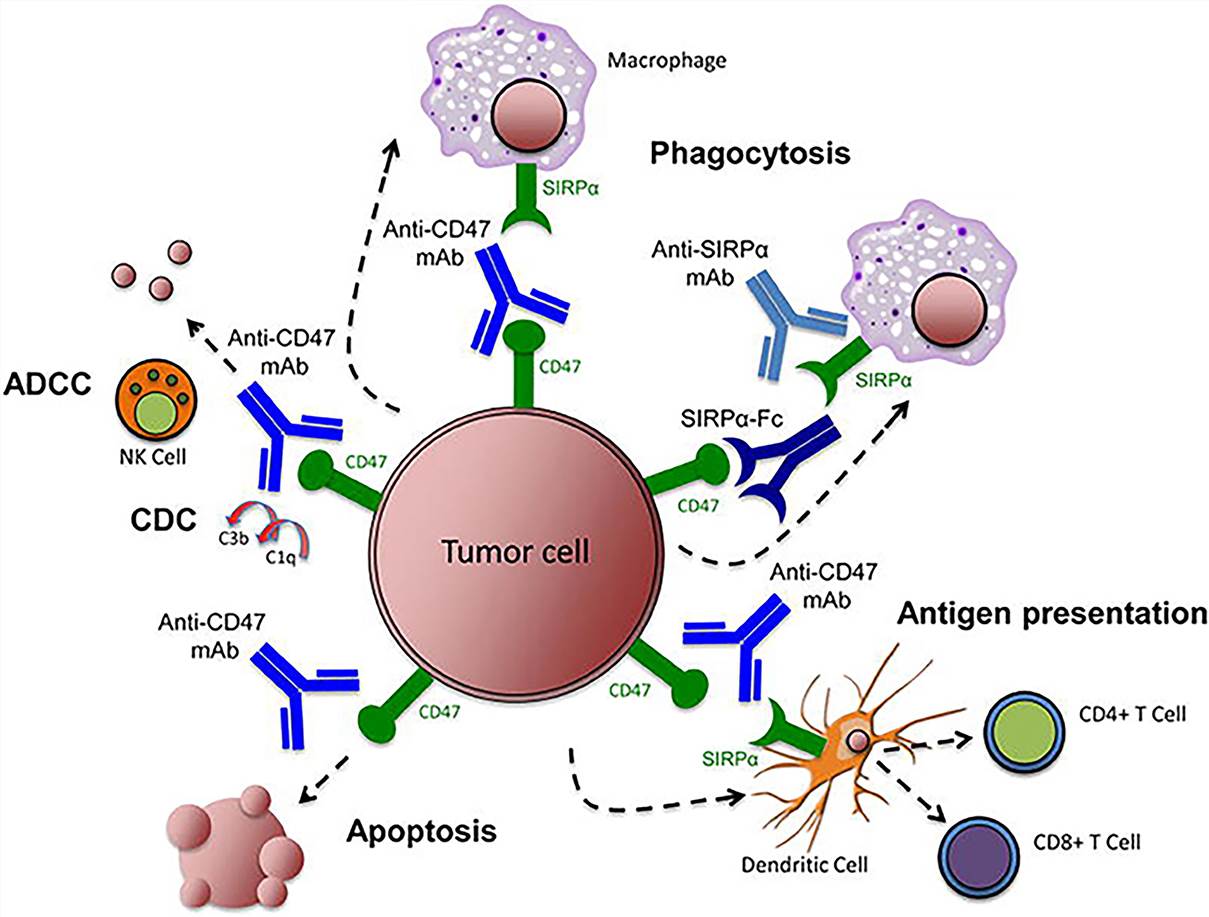CD47 Assay Portfolio Service
CD47, an immunoglobulin, is overexpressed on the surface of many types of cancer cells. Growing evidence has shown that CD47 is overexpressed in various hematological malignancies and plays an integral role in various immune responses as well as autoimmunity. With advanced and high-end technologies, rich experienced scientists, Creative Biolabs is an excellent service provider in the field of tumor marker assay. After long years ahead to fully comprehend tumor markers, we launch our CD47 assay portfolio service which can be useful for targeted cancer therapy and diagnosis.
Characteristics of CD47
CD47, a heavily glycosylated 50 Kd cell surface protein, belonging to the immunoglobulin family, has an extracellular N-terminal IgV domain, five transmembrane helices and a C-terminal cytoplasmic short variable spliced tail. CD47 is expressed by actually all cells in the body, including those that do not express integrins, such as erythrocytes. The ligands of CD47 include SIRPα, thrombospondin-1 (TSP-1), and integrins including αvβ3 and α2β1.
 Fig.1 Schematic representation of CD47 and its endogenous ligands TSP-1 and SIRP. (Sick, 2012)
Fig.1 Schematic representation of CD47 and its endogenous ligands TSP-1 and SIRP. (Sick, 2012)
Pathophysiological Functions of CD47
SIRPα, also known as CD172a, is a transmembrane glycoprotein that consists of an extracellular N-terminal domain composed of three immunoglobulin-like and a cytoplasmic domain, which has two tyrosine phosphorylation sites and four immunoreceptor tyrosine inhibitory motifs and expresses on myeloid cells and their precursors.
-
SIRPα binds to CD47 with the extracellular IgV domain, leading to tyrosine phosphorylation on the intracellular ITIM motif.
-
SIRPα binds to the SH2 domain-containing tyrosine phosphatases, which inhibits the accumulation of myosin IIA in phagocytic synapses and facilitates the release of "don't eat me" signals.
-
When the surface expression of CD47 is reduced, leading to the weakness of the CD47-SIRPα signaling pathway, macrophages can move toward and phagocytose these cells.
-
CD47 and its ligands mediate various pathophysiological processes, such as neutrophil chemotaxis and nervous system development, as well as playing a regulatory role in immune tolerance and T-cell activation.
CD47-SIRPα Signaling Pathway
CD47 can bind to the SIRPα to form the CD47-SIRPα signaling complex. The CD47-SIRPα pathway targeting therapy can cause the elimination of cancer cells through multiple mechanisms.
-
Anti-CD47 antibodies inhibit the CD47-SIRPα interaction, leading to phagocytic uptake of tumor cells by macrophages.
-
Anti-CD47 antibodies enable phagocytic uptake of tumor cells by dendritic cells and subsequent antigen presentation to CD4+ and CD8+ T-cells, thereby stimulating an anti-tumor adaptive immune response.
-
Anti-CD47 antibodies eliminate tumor cells through natural killer cell-mediated antibody-dependent cytotoxicity and complement-dependent cytotoxicity.
-
Anti-CD47 antibodies stimulate apoptosis of tumor cells through a caspase-independent mechanism.
 Fig.2 Targeting the CD47-SIRPα pathway in cancer. (Zhang, 2020)
Fig.2 Targeting the CD47-SIRPα pathway in cancer. (Zhang, 2020)
CD47 Blockade Assays at Creative Biolabs Including but Not Limited to:
-
Proliferation assay
-
Apoptosis assay
-
Adhesion assay
-
Migration assay
-
Angiogenesis assay
-
Cytotoxicity assay
-
Inflammation/immune responses assay
If you are interested in our service, please contact us or directly send us.
References
-
Zhang, W.; et al. Advances in anti-tumor treatments targeting the CD47/SIRPα axis. Front Immunol. 2020, 11: 18.
-
Sick, E.; et al. CD47 update: a multifaceted actor in the tumor microenvironment of potential therapeutic interest. Br J Pharmacol. 2012, 167(7): 1415-1430.
For Research Use Only | Not For Clinical Use


 Fig.1 Schematic representation of CD47 and its endogenous ligands TSP-1 and SIRP. (Sick, 2012)
Fig.1 Schematic representation of CD47 and its endogenous ligands TSP-1 and SIRP. (Sick, 2012)
 Fig.2 Targeting the CD47-SIRPα pathway in cancer. (Zhang, 2020)
Fig.2 Targeting the CD47-SIRPα pathway in cancer. (Zhang, 2020)
 Download our brochure
Download our brochure